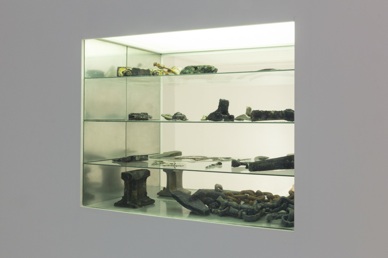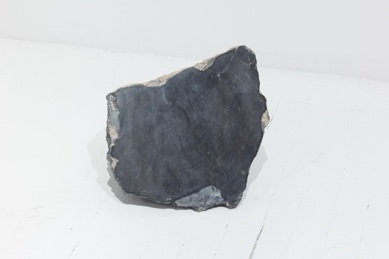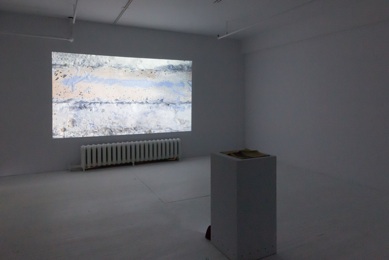A Modern Cult of Monuments
- Colin LYONS
Archaeologist of the Future – Colin Lyons
(…) Let’s imagine that everything was destroyed and a new race or a new group of beings came to our planet and they tried to discover our culture through the things that we left, and they find my works of art. So I have totally changed everything and nobody will ever know the truth.
Willie Cole 1
Memory and Ruins
Since the early 20th century, factories seem to have been transformed in accordance with new products and new production techniques. Like a phoenix, industry knows how to rise up from its ashes, no matter what the circumstances. It is these traces of past transformations that power the work of Colin Lyons. He is particularly interested in the status that we give to industrial ruins, and he is busy altering and moving real or captured fragments from these forgotten places.
In the body of work titled A Modern Cult of Monuments, the artist has treated various artefacts chemically, resulting in contrary effects. Some were very carefully soaked in acid, then removed and engraved to highlight the marks of corrosion. Others were corroded artificially and are hardly recognizable. Faced with these objects, the visitor is confused about their actual temporality. This illegibility elicits tension and questions arise. Where do these objects come from? What were they used for? At what period in our era have they been used? Unlike archaeologists and historians, the artist offers no answers. Rather, he invites us to invent possibilities for these works and to ask ourselves what will happen to our everyday objects.
In a poetic way, Lyons’s work evokes the impact of planned obsolescence on our relationship to the world, and especially on our relationship with time. Currently, everything is accelerating. Planned obsolescence seems to apply not only to objects but also to ways of doing, thinking and communicating. The impact of these changes, due mainly to new technology, is multiple. One finds with the abandonment of expertise that this results in the technological and social loss of reference points as well as the loss of individual and collective memory. With this, the artist’s Time Machine, developed to alter objects by both preserving them from corrosion and damaging them with corrosion, seems metaphorically to deceive time and the cycle of use that has been assigned them.
Parallel Time
Lyons’s skill lies in his ability to transport us beyond the walls of the gallery. Adopting the posture of an artist-as-archaeologist, he explored the Six-Mile Mill, a forgotten site located ten kilometres from Kamloops, British Columbia. It was here, in the ruins of an old factory that he intervened directly on the stones of the foundation, polishing them as though preparing them for producing a lithograph. The capturing of this place and this action is presented in the video New Monuments/Old Foundations. Faced with the moving image of the video, the viewer experiences parallel time, like in the work of Bill Viola. These different times are related to the history of the factory, to the artist’s actions and to the presentation in the gallery of objects from the site. The coexistence of these temporalities creates a series of dualities, particularly that of the industrial past as opposed to the artistic present. The sound environment of the video invades the gallery as well. We hear the sound of stones rubbing against each other and the rustle of grass, which contributes to the overall impression of physical and temporal movement. This is an invitation to be elsewhere, to take a break and to perceive time more slowly than usual.
Illusions
The arrival of new technology has complicated our relationship to the past. Computers allow us to feel more capable of preserving traces of the past. This impression, however, is only an illusion. Moreover, Lyons has experienced this. He attempted to find more information about the Six-Mile Mill but no trace of the factory has been preserved in the city’s archives. In this process, his work was similar to that of a detective. He took notes of the whole process in a work called Research into Industrial Remains Six Miles North of Kamloops. This project takes the form of a three-metre long brochure printed with ferric chloride ink, which ensures its rapid destruction. Here the artist combines his concerns about planned obsolescence, his interest in the ruins of industrial sites and the misplaced use of etching techniques. With all due modesty, he shares his process in this work and his quest for information, by determining the end of the story in advance.
Geneviève Goyer-Ouimette
1 Quote from Jocelyne Lupien and Jean-Philippe Uzel, Double Jeu : Identité et culture (Willie Cole, Ron Noganosh & Richard Purdy), Musée national des beaux-arts du Québec, Québec, 2004, p. 13. Original Quote: Willie Cole, interview in the exhibition catalogue for Social Studies 4 + 4 Young Americans, Allen Memorial Art Museum, Oberlin College, Oberlin, Ohio, 1990, p. 18.
2 Planned obsolescence is a business strategy designed to reduce the service life of a product in order to increase faster replacement frequency.
Colin Lyons was born in Windsor, Ontario in 1985. He grew up in ‘Canada’s original oil boomtown’ of Petrolia, Ontario, an experience that has fuelled his interests in industrial ruins and sacrificial landscapes. His recent work fuses printmaking, sculpture, and chemical experiments, pushing the role of the etching plate beyond its traditional boundaries as a re-enactment of the rise and fall of industrial economies. He explores industry through the lens of fragility and impermanence, considering planned obsolescence and the nature of what we choose to preserve.
Lyons received his BFA from Mount Allison University (2007) and MFA in printmaking from University of Alberta (2012). His work has been shown in solo exhibitions across Canada and the United States, as well as in group exhibitions internationally. Recent projects have been presented at Platform Stockholm (Stockholm, Sweden), The Soap Factory (Minneapolis, Minnesota), OBORO (Montreal, Quebec), ARTSPACE (Peterborough, Ontario), Judith & Norman Alix Art Gallery (Sarnia, Ontario), Klondike Institute of Art & Culture (Dawson City, Yukon), Kala Art Institute (Berkeley, California), and SPACES (Cleveland, Ohio). He currently lives in Hamilton, Ontario. He would like to thank the Canada Council for the Arts for their generous support of this project.
Geneviève Goyer-Ouimette has been director of CIRCA art actuel since 2013. She has a BA in Art History and an MA in Museology from University du Québec à Montréal. At the Musée national des beaux-arts du Québec, she worked in the Department of Conservation and Research, and was responsible for the Collection Prêt d’œuvres d’art (CPOA) (a rental collection of artworks for public agencies). As a curator, she has presented numerous group exhibitions including Projet HoMa (Maison de Culture Maisonneuve and Guido Molinari Foundation) and Ornementation identitaire (Mexican Consulate in partnership with the CALQ and the FONCA). She also presented the survey exhibitions of Catherine Bolduc’s work, Mes châteaux d’air (EXPRESSION Centre d’exposition de Saint-Hyacinthe and Salle Alfred-Pellan at Maison des arts de Laval) and Eric Ladouceur’s Possession / Knowledge / Power (Musée d’art contemporain des Laurentides and Graff Gallery). She has written essays for both artists and art magazines, on the work of Catherine Bolduc, Eveline Boulva, Yvon Chassé, Marc-Antoine K. Phaneuf, Éric Ladouceur and Marcel Marois. In November 2015, as curator, she will bring together the work of ten artists in an exhibition Dialogues about Space, which will be presented at CIRCA art actuel.






